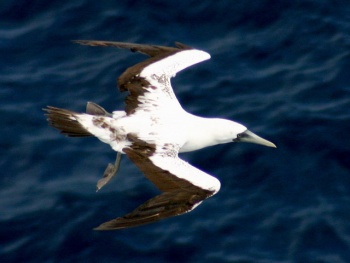- Sula dactylatra
Description
Belongs to the Sulidae family, along with the gannets, which are all diving seabirds, plunging into the sea from a great height after prey.
Identification :
Length: 81cm (32") Width: 158cm (62") White body, black tail and extensive black on wings. Yellow feet, yellow bill with black facial skin producing the mask. Juveniles have brown upper body with brown head, similar to molting young Northern Gannets, but have a pale collar.
Distribution & Taxonomy :
A rare and local year round resident in the West Indies with a total breeding population estimated to between 500 and 1700 pairs. In the Caribbean, known breeding areas are southern Bahamas (probably not the last 100 years), Jamaica, Puerto Rico, Virgin Islands, Anguilla, Antigua, and among the Grenadines; very rare elsewhere in the West Indies.
Found in the SW Atlantic Ocean, the Caribbean, the W. Indian Ocean, the E. Indian Ocean and most of the Pacific with the exception of the far south/central east where the closely related Nazca Booby (Sula granti) is found.
Previously, the Nazca Booby (Sula granti) was considered a race of the Masked Booby. In the Caribbean the Masked Booby (Sula dactylatra dactylatra) is the nominate race.
This photo was taken in the Caribbean, on the west side of the Lesser Antilles in Nov. 2004.
Habitat :
Pelagic - restricted to warmer regions, with the occasional wanderer to colder regions.
Behaviour:
Generally strictly pelagic (has been recorded more than 1,000 km. from land). Feeds almost exclusively on fish (less frequently squid) caught via a plunge-dive from moderate to great height. Regularly fall victim to piracy by Frigatebirds. Normally only seen close to the shore in the vicinity of the breeding colonies. Prefer to nest on cliff ledges (where take-off is easier), but will use the ground if no cliffs are available. Average is two eggs, but only rarely does more than a single chick survive. Individuals have been known to reach an age of 20+ years.




